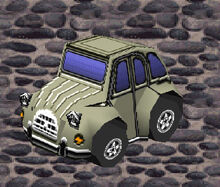(→Real life info: Adding info) Tag: Visual edit |
(→Real life info: Added info) Tag: Visual edit |
||
| Line 10: | Line 10: | ||
* [[Choro-Q!]] |
* [[Choro-Q!]] |
||
=== Real life info === |
=== Real life info === |
||
| − | Development of the Citroen 2CV began in 1936 as a series of TPV prototype cars; the 2CV was initially supposed to be launched in 1939 but France's involvement in World War II pushed back the 2CV's launch until 1948. The initial model, called the 2CV Type A, was powered by a 375 cc flat twin engine producing 9 hp and 14 lb/ft of torque, and came in one exterior color (gray). The 2CV was Spartan, featuring a retractable canvas roof, canvas trunk, one windshield wiper, and one brake light; the only gauges included a windshield pillar-mounted speedometer and an ammeter (because there was no fuel gauge, the fuel level was checked by a dip stick). |
+ | Development of the Citroen 2CV began in 1936 as a series of TPV prototype cars; the 2CV was initially supposed to be launched in 1939 but France's involvement in World War II pushed back the 2CV's launch until 1948. The initial model, called the 2CV Type A, was powered by a 375 cc flat twin engine producing 9 hp and 14 lb/ft of torque, mated to a 4-speed manual transmission, and came in one exterior color (gray). The 2CV was Spartan, featuring a retractable canvas roof, canvas trunk, one windshield wiper, and one brake light; the only gauges included a windshield pillar-mounted speedometer and an ammeter (because there was no fuel gauge, the fuel level was checked by a dip stick). |
In 1951, an ignition lock and lockable driver's door were added to the 2CV. A panel van model, the 2CV Fourgonnette, was introduced. |
In 1951, an ignition lock and lockable driver's door were added to the 2CV. A panel van model, the 2CV Fourgonnette, was introduced. |
||
| − | In 1954, a light was added to the speedometer. |
+ | In 1954, a light was added to the speedometer, and a 425 cc flat twin engine producing 12 hp and 14 lb/ft of torque became available (425 cc models were referred to as Type AZ). |
| + | |||
| + | In 1955, side turn signals were added above and behind the rear doors. |
||
In 1956, the compression ratio of the 375 cc engine was increased from 6.2 to 7. |
In 1956, the compression ratio of the 375 cc engine was increased from 6.2 to 7. |
||
| + | |||
| + | In 1957, the steering wheel color changed from gray to black, the windows were enlarged, and a heating/ventilation system was installed. The 2CV Type AZL, which has aluminum hood trim strips, was added to the lineup, along with the 2CV Type AZLP model, which has a trunk lid instead of a canvas-covered trunk. |
||
| + | |||
| + | In 1958, the 2CV Type AZL3 was built in Belgium, featuring rear corner side windows and higher build quality. |
||
| + | |||
| + | In 1960, the 425 cc engine gained a very slight power increase, to 12.5 hp; the 375 cc engine was discontinued. Styling revisions occurred, with front turn signals incorportated in the front fenders, the corrugated metal hood was replaced with a five-rib glossy hood, and the grille became flatter with a curved top edge. In late 1960, the 2CV Sahara was introduced, with 4-wheel drive and an additional engine/transmission in the rear of the vehicle. The two engines (and the axles) were operated separately and had separate fuel tanks; the transmissions were in simultaneous operation. The 2CV Sahara featured a hood-mounted spare tire. |
||
| + | |||
| + | In 1961, power increased to 13.5 hp. |
||
| + | |||
| + | In 1962, power increased to 15 hp and torque increased to 20 lb/ft. |
||
| + | |||
| + | In 1963, the Solex 26CBI carburetor was replaced with a Solex 28CBI unit, and power increased to 18 hp. |
||
| + | |||
| + | In 1965, the "suicide" (rear-hinged) doors were replaced with conventional front-hinged doors. |
||
| + | |||
| + | In 1967, torque increased to 21 lb/ft. |
||
The 2CV was produced through 1990. |
The 2CV was produced through 1990. |
||
Revision as of 00:43, 13 March 2019
The Citroen 2CV is a compact hatchback featured in the Choro-Q series. It appeared in the following Choro-Q Titles:
Real life info
Development of the Citroen 2CV began in 1936 as a series of TPV prototype cars; the 2CV was initially supposed to be launched in 1939 but France's involvement in World War II pushed back the 2CV's launch until 1948. The initial model, called the 2CV Type A, was powered by a 375 cc flat twin engine producing 9 hp and 14 lb/ft of torque, mated to a 4-speed manual transmission, and came in one exterior color (gray). The 2CV was Spartan, featuring a retractable canvas roof, canvas trunk, one windshield wiper, and one brake light; the only gauges included a windshield pillar-mounted speedometer and an ammeter (because there was no fuel gauge, the fuel level was checked by a dip stick).
In 1951, an ignition lock and lockable driver's door were added to the 2CV. A panel van model, the 2CV Fourgonnette, was introduced.
In 1954, a light was added to the speedometer, and a 425 cc flat twin engine producing 12 hp and 14 lb/ft of torque became available (425 cc models were referred to as Type AZ).
In 1955, side turn signals were added above and behind the rear doors.
In 1956, the compression ratio of the 375 cc engine was increased from 6.2 to 7.
In 1957, the steering wheel color changed from gray to black, the windows were enlarged, and a heating/ventilation system was installed. The 2CV Type AZL, which has aluminum hood trim strips, was added to the lineup, along with the 2CV Type AZLP model, which has a trunk lid instead of a canvas-covered trunk.
In 1958, the 2CV Type AZL3 was built in Belgium, featuring rear corner side windows and higher build quality.
In 1960, the 425 cc engine gained a very slight power increase, to 12.5 hp; the 375 cc engine was discontinued. Styling revisions occurred, with front turn signals incorportated in the front fenders, the corrugated metal hood was replaced with a five-rib glossy hood, and the grille became flatter with a curved top edge. In late 1960, the 2CV Sahara was introduced, with 4-wheel drive and an additional engine/transmission in the rear of the vehicle. The two engines (and the axles) were operated separately and had separate fuel tanks; the transmissions were in simultaneous operation. The 2CV Sahara featured a hood-mounted spare tire.
In 1961, power increased to 13.5 hp.
In 1962, power increased to 15 hp and torque increased to 20 lb/ft.
In 1963, the Solex 26CBI carburetor was replaced with a Solex 28CBI unit, and power increased to 18 hp.
In 1965, the "suicide" (rear-hinged) doors were replaced with conventional front-hinged doors.
In 1967, torque increased to 21 lb/ft.
The 2CV was produced through 1990.
Choro-Q

The 2CV is a mysterious body in Choro-Q.
Notes
- The 2CV is a mysterious body in the game; it goes by the name CLASSIC CAR and costs 10000 G.
- The 2CV in Choro-Q is a 1970s model.
- The roof is painted to match the body color.
- As with all bodies in Choro-Q, the tires aren't as detailed compared to later games and it is difficult to tell where the sidewalls and the tread meet on the tires.
Choro-Q 2

The 2CV is body number 31 in Choro-Q 2.
Notes
- The tires on the 2CV in Choro-Q 2 have darker sidewalls to distinguish the sides of the tires from the tread; in addition, the chrome trim is brighter than the Choro-Q version.
Choro-Q 3

The 2CV is body number 030 in Choro-Q 3.
Notes
- Although the 2CV in Choro-Q 3 is almost identical to the one in Choro-Q 2, the lower edges of the body are stretched slightly to accommodate slightly larger tires.
Choro-Q Park
The Citroen 2CV is a Safety-type vehicle and is body 56 in Choro-Q Park.
Notes
- The 2CV in Choro-Q Park is a first-generation model and has a canvas roof.
Choro-Q HG
The 2CV is body number 009 in Choro-Q HG.
Stats
- Type: Normal Choro-Q
- Weight: 20
- Obtained by: Available at Road Racer Body Shop for 500G
Notes
- The 2CV in Choro-Q is a 1970s model.
- The Choro-Q HG version has side mirrors, door handles, canvas roof, and large side vents on the front fenders.
Choro-Q HG 2

The 2CV is body number Q056 in Choro-Q HG 2. It can be found in the Sandpolis Body Shop.
Notes
- The 2CV in Choro-Q HG 2 is a 1970s model.
- It features a canvas roof and lacks the B-pillars on the doors.
Choro-Q HG 3

Just like its Choro-Q HG 2 counterpart, the 2CV is body number Q056 in Choro-Q HG 3. Unlike the Choro-Q HG 2 version, the rear fender flares are cut to expose the rear wheels, but is otherwise identical except for the coin holder on the back.
It is commonly found on Long Courses.
Choro-Q HG 4
The 2CV is body Choro-Q011 in Choro-Q HG 4.
Description (PAL)
"Ugly duckling born in France."
Description (NTSC)
"A car from France."
Notes
- The 2CV in Choro-Q HG 4 is identical to its Choro-Q HG counterpart.
- The Racing Paint/Special Paint version is similar to the Choro-Q HG version, but the decals on the windshield and windows have been removed.
Choro-Q!

In Choro-Q!, the 2CV is body Q74.
Notes
- The 2CV in Choro-Q! is similar in design to its Choro-Q HG 2 version, with the rear fender flares covering the rear wheels.





